
Massaua was the name in Italian language of the Eritrean city-port Massawa during Italian rule.

Massaua was the name in Italian language of the Eritrean city-port Massawa during Italian rule.
The Eritrean city of Massaua (now called "Massawa" or originally "Mitsiwa") was a colony of the Kingdom of Italy since the late 1890s until 1947, when Italy surrendered all the colonies in the peace Treaty after WW2.
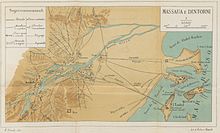
In those seven decades the city grew from a small village to a cosmopolitan city of nearly 100,000 inhabitants within the hinterland, that was the main port or Eritrea. After WW1 the city had an "urban plan". [1]
Eritrea officially became an Italian colony in 1890 and Massawa – already the seat of the colonial administration since 1885 – was declared the capital (but only for a few years until 1900 when the capital was established in Asmara).
On August 14, 1921, a violent earthquake occurred which destroyed 80% of the buildings. During the Government of Jacopo Gasparini, from 1923 to 1928, it was rebuilt and became an important center for the marketing of products and raw materials from all over Ethiopia, with the establishment (1925) of the free port and with the expansion of the town to the island of Taulud, where the railway station [2] and the church with a Catholic mission were also built.
In 1932 the port-city was connected to Asmara by a railway: the Eritrean Railway, [3] later expanded to Keren while projected until Tesseney and possibly to Kassala in Sudan.
In 1937 was inaugurated between Massaua and Asmara a big cableway (considered a world engineering masterwork in that year): the Asmara-Massawa Cableway. At 75 kilometres (47 mi) long, it was the longest ropeway conveyor in the world at the time. [4]
In the growing city was created an industrial area with ship repair yards, fish processing industries, of which the Red Sea is particularly prodigal, a grandiose cement factory and a large sea water distillation plant capable of 30 tons of ice and 700 tons of distilled water per day. Also a modern hospital was inaugurated in 1938. [5]
The airport of Massaua was usually called "Otumlo aeroporto" and was opened by the Italian authorities in 1935, when the Italian invasion of Ethiopia began, under the official name Aeroporto internazionale di Massaua. It was initially used for military aircraft employed in the invasion, and for military transport into conflict areas. In 1936, Ala Littoria, a civilian service with postal service from Massaua toward Asmara and Mogadishu, began operation at the airport. [6]
In the late 1930s the port of Massaua was served by international ocean liners, like the MS Vulcania and the Conte Biancamano, that also served the Port of Mogadiscio in Somalia and Genova in Italy. [7] [8] [9] [10]

The city in 1939 was second in Eritrea only to Asmara for the number of Italian citizens & military residents (they were nearly 10000): they used to live an italian way of life, going to the 3 cinemas just opened and to the many cafes & restaurants in the walking & strolling areas of the city.
A wider expansion of port areas on the island of Massawa was interrupted by Italy's entry into the war in 1940.
In spring 1941 the city was conquered by the British [11] and suffered heavy damages, while the port was blocked by the Italians with the sinking of many ships.
In summer 1941 Massaua was still administered by the italians -who were then receiving orders from the British- and had a "metropolitan" population of more than 105,000 (of which nearly 10,000 were italians). But soon the colonists disappeared and in 1946 -after the end of WW2- there were only one thousand of them in the city-port.
In Massawa actually there are only a few dozen of Italo-eritreans (descendants from italian fathers & grandfathers) and only some buildings remain of the Italian colonization decades. [12]

Eritrea is an ancient name, associated in the past with its Greek form Erythraia, Ἐρυθραία, and its derived Latin form Erythræa. This name relates to that of the Red Sea, then called the Erythræan Sea, from the Greek for "red", ἐρυθρός, erythros. But earlier Eritrea was called Mdre Bahri. The Italians created the colony of Eritrea in the 19th century around Asmara and named it with its current name. After World War II, Eritrea annexed to Ethiopia. Following the communist Ethiopian government's defeat in 1991 by the coalition created by various armed groups notably the EPLF and the TPLF among others, Eritrea declared its independence. Eritrea officially celebrated its 1st anniversary of independence on May 24,1993.
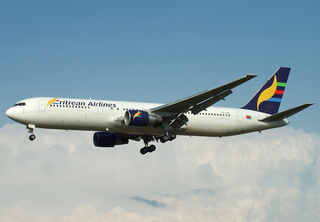
Transport in Eritrea includes highways, airports and seaports, in addition to various forms of public and private vehicular, maritime and aerial transportation.
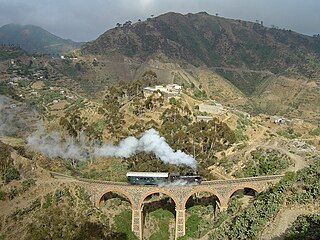
The Eritrean Railway is the only railway system in Eritrea. It was constructed between 1887 and 1932 during the Italian Eritrea colony and connects the port of Massawa with Asmara. Originally it also connected to Bishia. The line was partly damaged by warfare in subsequent decades, but was rebuilt in the 1990s. Vintage equipment is still used on the line.

Massawa or Mitsiwa is a port city in the Northern Red Sea region of Eritrea, located on the Red Sea at the northern end of the Gulf of Zula beside the Dahlak Archipelago. It has been a historically important port for many centuries. Massawa has been ruled or occupied by a succession of polities during its history, including the Kingdom of Aksum, the Ethiopian Empire, the Ottoman Empire and the Kingdom of Italy.

The Asmara-Massawa Cableway was a cableway built in Italian Eritrea before World War II.The Eritrean Ropeway, completed in 1937, ran 71.8 km from the south end of Asmara to the city-port of Massawa.

Massawa International Airport is an airport in Massawa, a major city in the Northern Red Sea region of Eritrea. It is considered to be the successor of the Otumlo Airport, also in Massawa, which was destroyed in 1941.
Modern banking in Eritrea started with the arrival of the Italian colonizers. However, from 1974 on, the banking sector became a government monopoly. This situation continued after Eritrea achieved its independence. The Bank of Eritrea is the central bank of Eritrea.
Articles related to Eritrea include:
The Italian guerrilla war in Ethiopia was a conflict fought from the summer of 1941 to the autumn of 1943 by remnants of Italian troops in Ethiopia and Somalia, in a short-lived attempt to re-establish Italian East Africa. The guerrilla campaign was fought following the Italian defeat in the East African Campaign of World War II, while the war was still raging in Northern Africa and Europe.

Eritrea, officially the State of Eritrea, is a country in the Horn of Africa region of Eastern Africa, with its capital and largest city at Asmara. It is bordered by Ethiopia in the south, Sudan in the west, and Djibouti in the southeast. The northeastern and eastern parts of Eritrea have an extensive coastline along the Red Sea. The nation has a total area of approximately 117,600 km2 (45,406 sq mi), and includes the Dahlak Archipelago and several of the Hanish Islands.

Italian Eritreans are Eritrean-born citizens who are fully or partially of Italian descent, whose ancestors were Italians who emigrated to Eritrea during the Italian diaspora, or Italian-born people in Eritrea.

Italian Eritrea was a colony of the Kingdom of Italy in the territory of present-day Eritrea. The first Italian establishment in the area was the purchase of Assab by the Rubattino Shipping Company in 1869, which came under government control in 1882. Occupation of Massawa in 1885 and the subsequent expansion of territory would gradually engulf the region and in 1889 borders with the Ethiopian Empire were defined in the Treaty of Wuchale. In 1890 the Colony of Eritrea was officially founded.
This is a survey of the postage stamps and postal history of Eritrea.
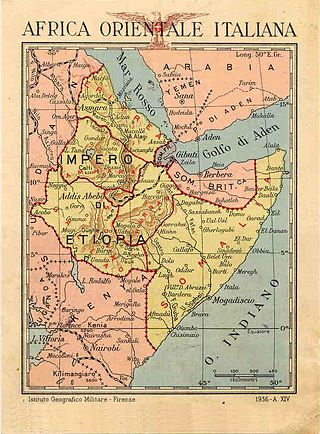
Eritrea Governorate was one of the six governorates of Italian East Africa. Its capital was Asmara. It was formed from the previously separate colony of Italian Eritrea, which was enlarged with parts of the conquered Ethiopian Empire following the Second Italo-Ethiopian War.

Asmara, the capital of Eritrea, first rose to prominence in medieval and post-medieval times. Though it had long overshadowed by nearby Debarwa, the residence of the Bahr Negash or the governor of the coastal province, it still existed as a major settlement for over half a millennium and enjoyed some importance as it stood on the trade route to Massawa. During the 20th century it was a staging ground for Italian initiatives in East Africa, collateral of Britain's colonial politics, and the subject of the expansion of Ethiopia until 1993, when the sovereign state of Eritrea was established. Despite the passage of over seventy years, the city has remained mostly unchanged in structural design, likely influenced by its position as a UNESCO World Heritage Site.

The Italian colonial railways started with the opening in 1888 of a short section of line in Italian Eritrea, and ended in 1943 with the loss of Italian Libya after the Allied offensive in North Africa and the destruction of the railways around Italian Tripoli. The colonial railways of the Kingdom of Italy reached 1,561 kilometres (970 mi) before WWII.
The following is a timeline of the history of the city of Asmara, Eritrea. Asmara was under Italian colonial rule from 1889 until 1941.

The Petrella Airport was the first international airport in Italian Somalia. It was opened in 1928 -just 3 miles south of Mogadishu- with the name "Enrico Petrella" in honor of an Italian pilot who died a few years before in the same airport of Italian Mogadiscio. In 1941 the airport was partially destroyed during WW2 and remained inactive for some years as a civilian airport: only military airplanes used it. In 1950 was reopened as a civilian airport by the Italian authorities of the ONU Fiduciary Mandate.
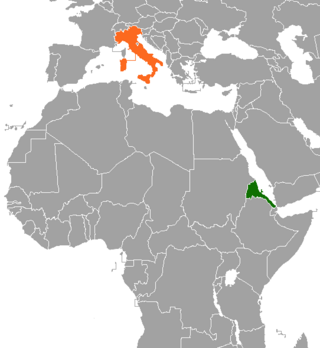
Eritrea–Italy relations are the bilateral relations between Italy and Eritrea. Both nations are members of the United Nations.